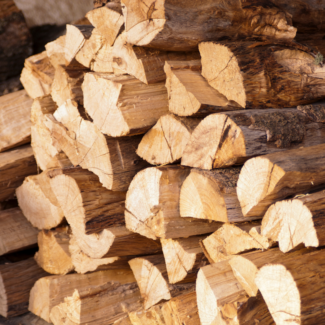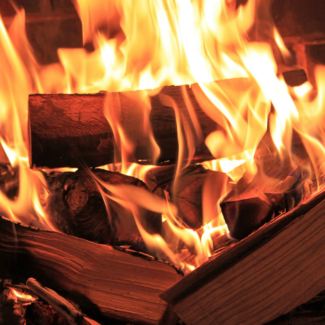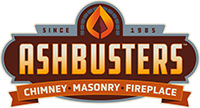With fall weather comes more fireplace use, which means if you have yet to schedule your annual inspection, it’s time to get it on the books! From there your sweep can determine whether or not a sweeping is in order and they can check for potential damages, too. Once any necessary repairs and preventative maintenance are completed, you should be good to start lighting fires and enjoying your system to the fullest!
…but wait. Have you put much thought into the firewood you’re using? Many underestimate just how vital it is to burn the right type of properly seasoned wood. In fact, some types of wood should not be burned indoors at all! If you own a fireplace, this is definitely one area you want to be knowledgable in.
That’s why we’re here to talk about it all and answer some common questions in this firewood 101 post!
Should You Buy Hardwood Or Softwood?
When it comes to firewood, you’ll typically want to buy hardwood over softwood. Why? Hardwoods are preferable because they’re denser and have more British Thermal Units (BTUs) available per piece of wood. Why are BTUs important? Essentially, the more BTUs your wood has, the more heat you’ll get from it, which then gives you the option to turn down your thermostat and save money on those monthly bills. (You’ll also be a lot cozier!)
Softwoods, on the other hand don’t burn as hot, and tend to create thick, dark smoke that both affects the ambiance of your space and creates more residue/creosote in the chimney.
Some examples of hardwoods include oak, ash, cherry, walnut, and maple, while a couple of the more common softwoods are pine and cedar.
Maple, oak and walnut are all premium types of wood to use in an indoor fireplace, so these are the types you should be burning if at all possible!
Is Your Wood Seasoned?
 Another important thing to keep in mind when purchasing wood is whether or not it has been properly seasoned. When you burn freshly-cut firewood, your fire will use up a lot of energy drying out all of that moisture. This reduces the amount of heat you wind up getting, and it also deposits gallons of acidic water into your chimney. This leads to corrosion and can cause significant damage to your masonry.
Another important thing to keep in mind when purchasing wood is whether or not it has been properly seasoned. When you burn freshly-cut firewood, your fire will use up a lot of energy drying out all of that moisture. This reduces the amount of heat you wind up getting, and it also deposits gallons of acidic water into your chimney. This leads to corrosion and can cause significant damage to your masonry.
Seasoned wood burns a lot cleaner and hotter. You’ll be less likely to experience smoke and odor problems, and you’ll avoid
excess creosote accumulation, too.
What qualifies as seasoned wood? Seasoned wood will have been aged for at least 6 months, and its moisture content should be around 15 – 25% (as opposed to fresh wood that typically has a moisture content of about 45%). In the end, you don’t want it too dry or too wet – there’s a sweet spot in there where the wood will burn properly.
How can you tell if your firewood is seasoned before you buy it?
- Check the length. The shorter the piece, the quicker it will dry out, so there’s a higher chance that it will have less water.
- Examine the ends. Are they dark and split? Both of these are good signs that the wood has been properly dried out. Splitting the ends of the wood ensures there’s more surface area exposed to the sun and wind, and it’ll be more likely to dry out quicker.
- Test its weight. You’ll want to go with the lightest logs you can find. If one feels a bit on the heavier side, then there’s likely more water inside weighing it down, and it won’t burn as cleanly or as hot.
- Smell it. Does it smell old and musty or fresh and green? A pleasant, fresh aroma is more desirable in most scenarios, but not when it comes to picking firewood! In this case, the mustier, the better.
- Smack two pieces together. If you hear a hollow clunking noise, this indicates most of the water has been dried out of the log. If the wood is wet or full of water, you’ll hear more of a dull thud.
- Purchase a moisture meter. Even the best-looking wood can be deceiving, so if you want to be totally sure you’re getting the best logs out there, then consider buying a moisture meter. These can be found online for around $30 – $50, and they’ll quickly and accurately tell you if the wood your purchasing is ready to burn.
Where Can You Buy Firewood In Nashville, TN?
You can find firewood for sale in a variety of places here in Nashville! But what’s good and what isn’t? A lot of times, wood at gas stations is kiln-dried, and that can make for great firewood.
There are also a lot of local dealers in the area, so if you don’t already have someone you can trust, ask your friends, family, and neighbors for their recommendations. Buying local is always a good call, as firewood from other parts of the country or world can be an easy way for invasive insects and species to enter other areas.
Buying firewood off of the side of the road or having it delivered? Always ask to make sure it’s seasoned. But keep in mind that the seller will almost always tell you it’s seasoned, regardless of whether or not it really is. Try to get a good look at the firewood prior to purchasing or, better yet, test it with a moisture meter.
What Else Should You Avoid Burning In Your Fireplace?
 Okay, so now you know exactly what type of wood to burn in your fireplace, as well as what to avoid. But are there other things you should never burn?
Okay, so now you know exactly what type of wood to burn in your fireplace, as well as what to avoid. But are there other things you should never burn?
Well, a lot of people use their fireplace as an incinerator, and that’s really not what it’s for. Christmas trees are one of the worst offenders – and the most dangerous. After drying out in your home for a month, they’re so flammable that they light up fast and can quickly get out of control and cause a house fire, putting your entire household at risk.
A good rule of thumb is to only burn seasoned firewood and absolutely nothing else. That means no burning trash, plastic silverware, paper plates, holiday wrapping paper, cardboard boxes, old mail, books/magazines, or anything else similar. These items produce smoke and harmful fumes that encourage creosote buildup and they create a less than pleasant fireplace experience, too.
Ready for the Holidays?
Before we know it, we’ll be enjoy Halloween, then Thanksgiving, then Christmas! The holidays always come up fast, so be ready for it all by having your chimney professionally inspected and cleaned by one of our CSIA certified chimney sweeps. We’ll check to make sure everything is safe for use and let you know whether or not any cleaning or repairs are needed before the first fire of the season.
And if you have more questions on the best firewood to use in your fireplace, give the pros at Ashbusters Chimney Service a call or reach out online today! And in the meantime, remember these four rules the next time you buy your own:
- Hardwoods make great firewood – softwoods don’t.
- Seasoned wood is firewood with a roughly 15 – 25% moisture reading.
- Never burn wood that is wet.
- If the wood looks and smells old and makes a hollow “clunk” when smacked together, you should be good to go!
Thanks for choosing us – we look forward to working with you soon!
